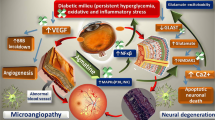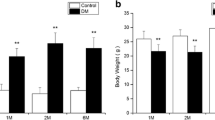Abstract
Vasoregression characterizes diabetic retinopathy in animal models and in humans. We have recently demonstrated that vasoregression is earlier initiated in a rat model of ciliopathy-induced retinal neurodegeneration (TGR rat). The aim was to assess the balance between vasoregressive effects of chronic hyperglycemia and photoreceptor degeneration on adult vascular remodelling. The retinas were analyzed at 4 and 9 months after streptozotocin-induced diabetes. Neurodegeneration was determined by quantitation of cell numbers and retinal layer thickness. Vasoregression was assessed by quantitative retinal morphometry in retinal digest preparations. Retinal VEGF levels were measured by ELISA. Glial activation, expression and location of HSP27 and phosphorylated HSP27 were evaluated by immunofluorescence staining. Unexpectedly, the numbers of acellular capillaries were reduced at both time points and led to fewer intraretinal microvascular abnormalities in late stage diabetic TGR. Concomitantly, inner nuclear layers (INLs) in diabetic TGR rats were protected from cell loss at both time points. Consequently, glial activation was reduced, but VEGF level was increased in diabetic TGR retinas. Expressions of HSP27 were upregulated in glia cells in the preserved INL of diabetic TGR. Chronic hyperglycemia preserves the microvasculature in the retinal model of neurodegeneration. Cell preservation in the retinal INL was associated with protective gene regulation. Together, these data indicate that diabetes can induce vasoprotection, in which retinal glia can play a particular role.




Similar content being viewed by others
References
Hammes HP, Feng Y, Pfister F, Brownlee M (2011) Diabetic retinopathy: targeting vasoregression. Diabetes 60:9–16
Feng Y, vom Hagen F, Lin J, Hammes HP (2007) Incipient diabetic retinopathy–insights from an experimental model. Ophthalmologica 221:269–274
Feng Y, Wang Y, Stock O, Pfister F, Tanimoto N et al (2009) Vasoregression linked to neuronal damage in the rat with defect of polycystin-2. PLoS One 4:e7328
Feng Y, Wang Y, Li L, Wu L, Hoffmann S et al (2011) Gene expression profiling of vasoregression in the retina–involvement of microglial cells. PLoS One 6:e16865
Gallagher AR, Hoffmann S, Brown N, Cedzich A, Meruvu S et al (2006) A truncated polycystin-2 protein causes polycystic kidney disease and retinal degeneration in transgenic rats. J Am Soc Nephrol 17:2719–2730
Hammes HP, Lin J, Bretzel RG, Brownlee M, Breier G (1998) Upregulation of the vascular endothelial growth factor/vascular endothelial growth factor receptor system in experimental background diabetic retinopathy of the rat. Diabetes 47:401–406
Brooks SE, Gu X, Kaufmann PM, Marcus DM, Caldwell RB (1998) Modulation of VEGF production by pH and glucose in retinal Muller cells. Curr Eye Res 17:875–882
Abu El-Asrar AM, Meersschaert A, Dralands L, Missotten L, Geboes K (2004) Inducible nitric oxide synthase and vascular endothelial growth factor are colocalized in the retinas of human subjects with diabetes. Eye (Lond) 18:306–313
Eichler W, Kuhrt H, Hoffmann S, Wiedemann P, Reichenbach A (2000) VEGF release by retinal glia depends on both oxygen and glucose supply. NeuroReport 11:3533–3537
Arden GB (2001) The absence of diabetic retinopathy in patients with retinitis pigmentosa: implications for pathophysiology and possible treatment. Br J Ophthalmol 85:366–370
de Gooyer TE, Stevenson KA, Humphries P, Simpson DA, Gardiner TA et al (2006) Retinopathy is reduced during experimental diabetes in a mouse model of outer retinal degeneration. Invest Ophthalmol Vis Sci 47:5561–5568
Pfister F, Riedl E, Wang Q, vom Hagen F, Deinzer M et al (2011) Oral carnosine supplementation prevents vascular damage in experimental diabetic retinopathy. Cell Physiol Biochem 28:125–136
Tytell M, Hooper PL (2001) Heat shock proteins: new keys to the development of cytoprotective therapies. Expert Opin Ther Targets 5:267–287
Kurihara T, Westenskow PD, Bravo S, Aguilar E, Friedlander M (2012) Targeted deletion of VEGFa in adult mice induces vision loss. J Clin Invest 122:4213–4217
Bandello F, Lattanzio R, Zucchiatti I, Del Turco C (2013) Pathophysiology and treatment of diabetic retinopathy. Acta Diabetol 50:1–20
Berkowitz BA, Bissig D, Ye Y, Valsadia P, Kern TS et al (2012) Evidence for diffuse central retinal edema in vivo in diabetic male Sprague Dawley rats. PLoS One 7:e29619
O’Reilly AM, Currie RW, Clarke DB (2010) HspB1 (Hsp 27) expression and neuroprotection in the retina. Mol Neurobiol 42:124–132
Acknowledgments
This study was supported by grants from the DFG, the DDG and the GRK 880. The authors thank Petra Bugert, Nadine Dietrich and Valerie Schwarz for their grateful support.
Author information
Authors and Affiliations
Corresponding author
Additional information
Communicated by Guido Pozza.
Rights and permissions
About this article
Cite this article
Feng, Y., Wang, Y., Yang, Z. et al. Chronic hyperglycemia inhibits vasoregression in a transgenic model of retinal degeneration. Acta Diabetol 51, 211–218 (2014). https://doi.org/10.1007/s00592-013-0488-4
Received:
Accepted:
Published:
Issue Date:
DOI: https://doi.org/10.1007/s00592-013-0488-4




